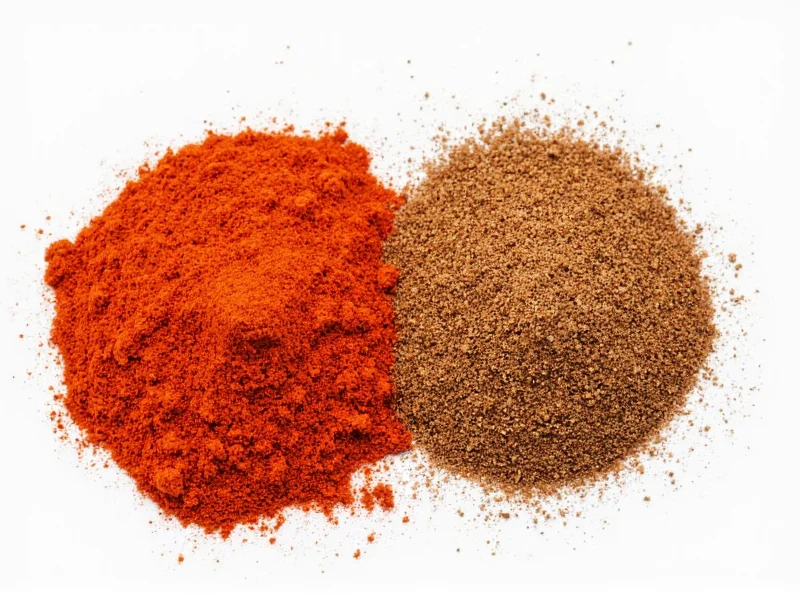Understanding the differences between cayenne pepper and paprika is essential for home cooks and professional chefs alike. These two vibrant red spices often sit side by side in spice racks, leading to confusion about when to use each. While they share visual similarities, their flavor profiles, heat levels, and culinary applications vary dramatically, making them non-interchangeable in many recipes.
Origin and Production Methods
Cayenne pepper originates from the Capsicum annuum var. minium species, typically grown in tropical climates. The peppers are harvested when fully ripe, dried, and then ground into a fine powder. Authentic cayenne contains little more than the dried peppers themselves, though some commercial blends may include additives like garlic powder or퀵 salt.
Paprika, by contrast, comes from various sweet or hot pepper varieties within the Capsicum annuum family. The production process involves drying peppers and grinding them into powder, but the specific pepper varieties used create significant differences. Hungarian paprika, considered the gold standard, uses specific pepper varieties dried over special ovens that impart subtle smoky notes. Spanish paprika (pimentón) often undergoes smoking over oak fires, creating distinct flavor variations.
Heat Level Comparison
The most dramatic difference lies in their heat levels. Cayenne pepper consistently delivers significant heat, measuring between 30,000 and 50,000 Scoville Heat Units (SHU). This places it firmly in the medium-hot category, comparable to bird's eye chilies.
Paprika's heat varies dramatically by type:
| Type of Paprika | Scoville Heat Units | Heat Level Description |
|---|---|---|
| Sweet Paprika | 0-500 SHU | Mild, no noticeable heat |
| Hot Paprika | 5,000-15,000 SHU | Moderate heat, similar to jalapeños |
| Smoked Paprika (Pimentón) | Variable (sweet to hot) | Smoke flavor with varying heat |
| Cayenne Pepper | 30,000-50,000 SHU | Significant, consistent heat |
When comparing cayenne pepper vs paprika heat, cayenne is consistently 6-100 times hotter than most paprika varieties. This dramatic difference explains why substituting one for the other can ruin a dish.
Flavor Profiles Beyond Heat
Cayenne offers a straightforward, sharp heat with minimal complexity. Its flavor profile is primarily defined by its intense spiciness with subtle earthy notes. High-quality cayenne maintains a clean, pure chili flavor without bitterness.
Paprika provides much more nuanced flavor profiles depending on the variety:
- Sweet paprika: Earthy, slightly sweet, with notes of red bell pepper
- Smoked paprika: Distinctive wood-smoke flavor with varying heat levels
- Hot paprika: Noticeable heat combined with sweet pepper notes
- Hungarian paprika: Complex flavor with fruity, floral notes alongside moderate heat
Understanding the difference between cayenne and smoked paprika is particularly important, as their applications rarely overlap despite both being red chili powders.
Culinary Applications and Pairings
Cayenne pepper shines in applications where direct heat is desired without competing flavors. It's commonly used in:
- Hot sauces and condiments
- Cajun and Creole seasoning blends
- Meat rubs for bold heat
- Spicy chocolate and dessert applications (in small amounts)
- Asian stir-fries requiring straightforward heat
Paprika's versatility makes it suitable for a wider range of applications:
- Sweet paprika: Deviled eggs, potato salads, finishing touch on soups
- Smoked paprika: Paella, barbecue rubs, roasted vegetables, Spanish cuisine
- Hot paprika: Goulash, stews, meat dishes requiring both color and moderate heat
When considering can I substitute paprika for cayenne pepper, the answer depends on the recipe's requirements. In dishes where heat is the primary goal, substitution isn't advisable. However, in recipes where color and mild pepper flavor are needed, sweet paprika can sometimes replace cayenne in reduced quantities.
Nutritional Comparison
Both spices offer nutritional benefits as concentrated sources of capsaicinoids and antioxidants, but with some differences:
| Nutrient | Cayenne Pepper (1 tsp) | Sweet Paprika (1 tsp) |
|---|---|---|
| Calories | 5.6 | 5.5 |
| Vitamin A | 44% DV | 16% DV |
| Vitamin E | 3% DV | 2% DV |
| Vitamin B6 | 3% DV | 2% DV |
| Iron | 2% DV | 1% DV |
| Capsaicin Content | High | Low to moderate |
Cayenne contains significantly more capsaicin, the compound responsible for heat and many health benefits including metabolism boost and pain relief. Paprika, particularly sweet varieties, contains higher levels of carotenoids that provide its vibrant color and antioxidant properties.
Storage Recommendations
Both spices lose potency over time but require similar storage conditions:
- Store in airtight containers away from light and heat
- Keep in a cool, dark cupboard (not above the stove)
- Replace every 6-12 months for optimal flavor
- Consider refrigeration in humid climates
When properly stored, cayenne maintains its heat longer than paprika retains its nuanced flavors. Many chefs recommend replacing paprika more frequently to preserve its delicate flavor notes.
Common Misconceptions
Several myths persist about these spices:
- Myth: All paprika is mild - Reality: Hot paprika varieties exist and can approach cayenne's heat level
- Myth: Cayenne and red pepper flakes are identical - Reality: Red pepper flakes contain multiple chili varieties and have texture differences
- Myth: Paprika is just mild cayenne - Reality: They come from different pepper varieties with distinct flavor compounds
- Myth: Hungarian paprika is always hot - Reality: Traditional Hungarian paprika ranges from sweet to hot varieties
Practical Substitution Guidance
When you need to substitute one for the other, consider these guidelines:
- To replace cayenne with paprika: Use 1 teaspoon hot paprika for ¼ teaspoon cayenne (adjust to taste)
- To replace paprika with cayenne: Use ⅛ teaspoon cayenne for 1 teaspoon sweet paprika, plus a pinch of smoked salt if mimicking smoked paprika
- For color without heat: Use sweet paprika instead of cayenne
- For heat without smoke: Use cayenne instead of smoked paprika
Understanding when to use cayenne instead of paprika can transform your cooking. Cayenne works best when you want straightforward heat, while paprika shines when you need color and complex flavor without overwhelming spice.











 浙公网安备
33010002000092号
浙公网安备
33010002000092号 浙B2-20120091-4
浙B2-20120091-4